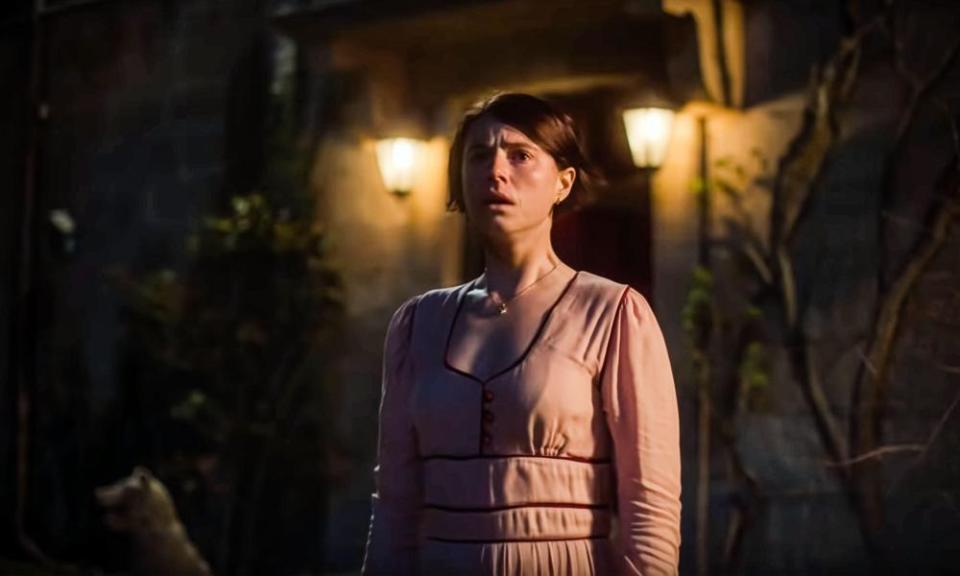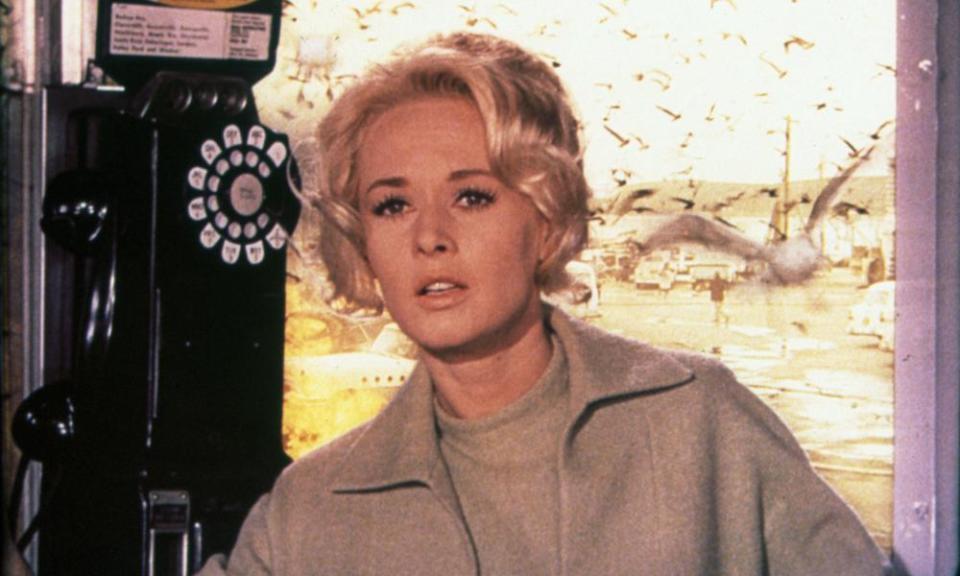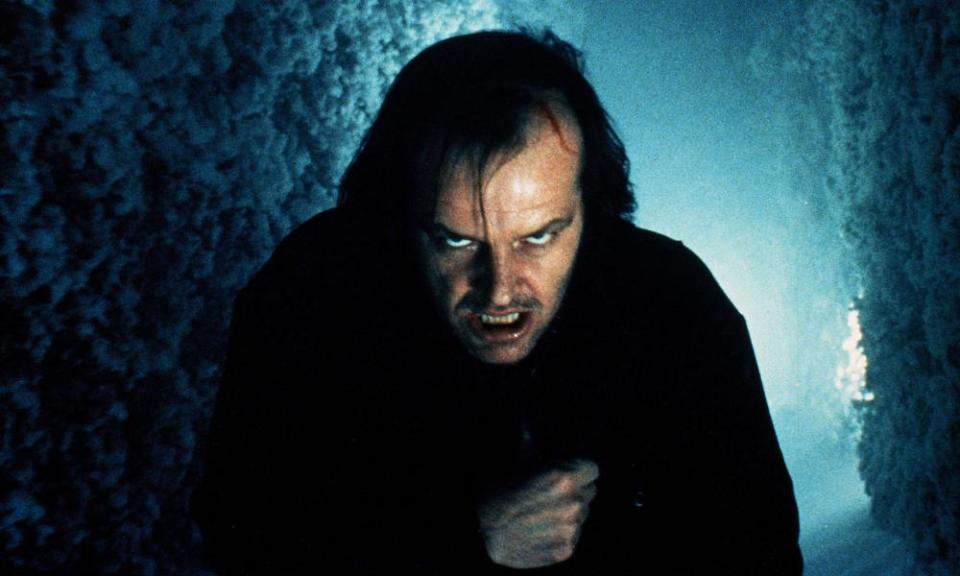‘I squeamishly refuse to rewatch’: Guardian writers on their scariest movie endings
The Blair Witch Project
Has more than two decades of found-footage horror further blunted the impact of The Blair Witch Project, which plenty of folks were already shrugging off as boring and unscary back in 1999? Maybe, but not for me. I can’t claim that I saw Blair Witch early enough to mistake its convincing faux-documentary setup for reality, but I did manage to catch it before it reached a wide enough audience to inspire countless jokes and spoofs (I can only imagine the cheesy memes we’d have to endure if it came out today), and it’s stuck with me ever since; I need only to think of its final shot, and I shiver.
The handheld, conversational style of movie, following a group of documentarians who get lost in the woods of Maryland while making a movie about a spooky local legend builds into a naturalistic horror show where every rustle of twigs provokes anxiety. It builds to a magnificently evocative, upsetting, yet simple image: Heather (Heather Donahue) coming upon her friend Mike (Michael Williams) in the basement of an abandoned house, standing in a corner, mournfully facing the wall, matching the description of decades-earlier murder victims from earlier in the film. Then, of course, something unseen attacks the person holding the camera and cuts it off. Every found-footage horror movie since has more or less ended the same way, and none with quite this level of elemental folk-horror staying power. Jesse Hassenger
Get Out

The final scene in Get Out still gives me chills. Chris is bloody but breathing – but so is Rose, his now ex-girlfriend. And when a police car creeps up to her house with lights flashing, just as she’s found her strength again, naturally, I assume the worst: that this Black man who tried so hard to be a good house guest is gonna go down for murdering Rose’s entire family.
When best friend Rod emerges to save Chris and leave Rose to bleed out, most breathed a sigh of relief and went home happy. But not me; I knew that’s not how it was supposed to go. So when director Jordan Peele later released an alternate ending that not only showed Chris taking the fall, but appearing defeated in an orange jumpsuit behind glass while telling Chris, working diligently to free him, that it’s a lost cause. That’s the bit that scares me: the truth that was left out. Andrew Lawrence
Don’t Look Now
In Nicolas Roeg’s avant-horror landmark, a bereaved Donald Sutherland is stalked around Venice by a shadowy figure in the same red jacket his late daughter was wearing when she drowned; he catches up with his pursuer in the final scene, only to discover that she’s an aged dwarf, and that his recurring dreams were actually premonitions of his own murder at her hands.
On top of the petrifying terror inherent in a reveal so impossible to anticipate that it borders on the non sequitur – turns out that it’s true what they say about nothing being scarier than the unknown – the collapsing of time adds a higher layer of unease. How far into the future can our reluctant prophet see? In the wizened physiognomy of his killer, he may get a glimpse of the life his child never got the chance to live, his mortality bound up in hers. It’s the monster lurking at the end of every story: everybody dies. Charles Bramesco
Enemy
I never really had the opportunity to develop a phobia of spiders. Growing up as the only male in my household meant that I was forever called upon as official dispatcher developing a weird form of intimacy that led me to feel sorry, rather than scared, for the things. But any vague sympathy I might have had was instantly vanquished in the final, breath-stealing scene of Denis Villeneuve’s eerie and elliptical thriller Enemy.
It’s a film that keeps us in the murk for the most part, an opaque little curio about two identical men, played by Jake Gyllenhaal, exploring their thorniest desires, but it’s never less than uncomfortably alluring, even as we’re scrambling to piece together a puzzle with several pieces missing. One that we’re given but not entirely sure what to do with is a recurring motif of the spider, seen in an unsettling sex club before looming over the city in a strange dream. In the final moments, with a rare jump scare achieved without cheating, one of our doubles opens the bedroom door to find a giant tarantula which, in a move that still haunts me, instinctively retreats as if ready to pounce. Instead, Villeneuve lingers on Gyllenhaal’s face before fading to black, pulling us, like him, to the very edge and then cruelly leaving us there … Benjamin Lee
Dressed to Kill
Set in Ed Koch-era Manhattan, a sultry haze hangs over Brian De Palma’s chic erotic slasher Dressed to Kill, reminding us of a time when New York felt thrillingly un-synthetic. We’re thrown into a day in the life of glamorous housewife Kate Miller (played by then 49-year-old Angie Dickinson). Morning sex with her clod of a husband, a visit to her worldly shrink (Michael Caine), a moment’s reflection in front of a billboard-size Alex Katz painting at the Met, then afternoon sex with a stranger. De Palma prowls about his side of the camera like a wildcat, mixing slow motion with flashes of terror to entrancing effect. White wine lunches and languorous close-ups of hands flipping through other people’s Rolodexes are spliced against cheaper thrills: beady-eyed voyeurs and paranoid prostitutes, screeching taxi cabs, a gruesome killing in the elevator of a luxury apartment building. This Hitchcockish sequence is the one that film nerds tend to dwell on, but the final scene is the one that I’ve found harder to shake all these years after my first viewing.
The analyst has been locked away in an insane asylum, where he strangles a nurse, changes into her uniform and finds his way to Liz Blake (Nancy Allen), the sweetheart prostitute who is onto his double life as a cross-dressing murderer. Sensing that something is amiss, Liz backs into a corner of the shower, the steam building into a thick fog as she tries to think quick. We’ve all been there: alone (or so we thought), defenseless, utterly unprepared for what’s around the corner, especially an unfettered maniac wielding a knife. Liz wakes up in a cold sweat. Nobody slashed her throat after all. But she’s still screaming over the nightmare lodged in her head, and with good reason. Ask any analyst. Lauren Mechling
Men

Audiences were divided on Alex Garland’s allegory about the historic and ever-multiplying tentacles of toxic masculinity, but there was broad consensus that Men’s final 20 minutes is the most bonkers ending of the year. (“400% more birth than expected,” reads one succinct Letterboxd review.)
In Men, Jessie Buckley is dealing with a recent trauma on a solo weekend in the British countryside, where she encounters a series of village men who all oddly look like Rory Kinnear. But the pastoral folk-horror vibe turns gory and horrifically grotesque in the last act, when a naked man she’s believed to be a stalker gives birth to four versions of himself in what Garland has called “a rolling birth sequence”. Inspired by David Cronenberg, The Thing and An American Werewolf in London and grounded in Garland’s fascination with the Green Man and sheela-na-gig fertility symbols, the finale – a feat of prosthetics and VFX – manages to be both gloriously graphic and bloody and puzzlingly enigmatic (as evidenced by numerous think pieces). Or at least I think it does, as I squeamishly refuse to rewatch. Lisa Wong Macabasco
The Vanishing
“That can’t be it,” my friend said, her face a sickly shade of grey, as the credits rolled on Dutch director George Sluizer’s stark, simple and wholly merciless missing-persons nightmare from 1988. I assured her it was. “You can’t do that. It shouldn’t be allowed. What am I supposed to do now?”
It’s the natural response to the plain, brutal resolution of this story about a young man haunted by his girlfriend’s disappearance into thin air one afternoon at a roadside service station. Having tracked down, after several years, the man with the answer, he’s told he can only experience her fate for himself. He drinks a cup of spiked coffee. He wakes up in a coffin underground. Fin. It’s the greatest of all horror endings, playing on the basest of human fears, offering up not a twist but the most obvious and awful of all possible answers. It’s so unimprovable that Sluizer himself could only cock it up, five years later, in his botched Hollywood remake. That film’s happy ending lingered not a second in the popular imagination; the nihilistic original plagues us still. Guy Lodge
The Lodge
The second feature from up-and-coming horror duo Veronika Franz and Severin Fiala skips the cheap scares in favor of a slow, careful build of fear, psychological depth and claustrophobia. Richard plans to take his two young children to an isolated, snow-covered house for a holiday getaway with his new girlfriend, Grace. The problem is that Richard’s kids hold Grace responsible for the suicide of their mother six months earlier. The even bigger problem is that as a child Grace was the sole survivor of a mass suicide perpetuated by a religious cult led by her father, and she now relies on medication to control serious mental illness. When Richard leaves the lodge for a few days, things start to get weird between Grace and the kids.
Part of the creepiness of Franz and Fiala’s feature is that the morality of The Lodge is so hopelessly complicated: we can’t say who’s the actual villain, as there are reasons to both empathize with and blame Grace and Richard’s children. As things become tighter, stranger, and more desperate, the movie takes on the inevitability of tragedy, and even as its seemingly paranormal events are explained, it never quite shakes the sensation that an evil beyond mere human fallibility is at play here. It all rises to a feverish, shattering climax and a methodical, relentless denouement that guarantees that The Lodge sends away still clutching its worst scare of all. Veronica Esposito
Midsommar

Ari Aster’s 2019 folk horror film Midsommar takes an eerie emotional journey through grief via a Swedish pagan ritual – uncanny smiles and mushroom trips, human sacrifice in broad daylight, blood and guts delivered in haunting images and creeping shots. (AKA the upper limit of what I, a scaredy cat afraid of gore, can handle.)
But it’s the final scene, in which orphaned Dani (an always magnetic Florence Pugh) chooses to sacrifice her wet blanket of a boyfriend Christian (Jack Reynor) over a randomly selected village person, that elevates the film into a twisted fairy tale of catharsis. As Christian, paralyzed and sewn into a gutted bear, burns alive, the villagers writhe in despair – or is it terror, relief, ecstasy? The final shot – Dani’s face, framed by her May Queen flower crown, melting from horror into a smile – is an unnerving exclamation point. Several deaths, a purge, a new family – it’s a strange, gut-twist finale, somehow at once soothing and nauseating, that seals the film beneath your skin. Adrian Horton
The Birds

Though not exactly a horror film per se, Alfred Hitchcock’s The Birds is one of the creepiest films of all time, and one that means I can’t ever pass a kids’ climbing frame without flinching.
The first time I saw the film I remember being somewhat nonplussed by the final scene, expecting the human cast to be subject to a holocaust of savage beaks, ripping talons and tornadoing feathers. But seeing it again, I realised just how miserable the film’s conclusion is: a coda to the narrative’s step-by-step dismantling of the characters’ veneer of civilisation and descent into a kind of communal psychic breakdown. As the battered humans file carefully past the watchful but unfussed avians, it’s clear that it’s their planet now, and we are the losers. It might the scariest moment Hitchcock ever put on film; it’s certainly the bleakest. Andrew Pulver
Cam
Virtual identities and the dark recesses of online existence have been well explored in scary movies, as has the concept of doppelgangers. Director Daniel Goldhaber’s gut-busting feature debut refreshes the latter by merging it with the former, following a cam girl named Alice (Madeline Brewer) who grows her audience by combining nudity with outlandishness and grotesquery. “I slit my throat last night … everybody in my room loved it,” she tells a friend, after faking her own suicide to climb the ranks of a site called FreeGirls.Live.
Things get very weird when Alice discovers her ultimate competitor appears to be herself: someone or something that looks exactly like her and is stealing her fans. Goldhaber’s tight, twitchy, angsty atmosphere comes to a head during a terrifying finale in which Alice challenges her virtual doppelganger to imitate her, the prize (if it can’t keep up) being the password to its account. All the protagonist needs to do to win is slam her face on the desk and break her own nose – signifying a rather brutal password recovery system. Luke Buckmaster
The Shining

The Shining is unshakable because we’re terrified of what we don’t understand. The black-and-white photograph the movie ends with seals the deal, leaving us begging for answers to questions that will go on haunting us.
Is that Jack Torrance – the struggling-author played by a wily Jack Nicholson – smiling at the forefront of the half-century old picture? Did the murderous axe-wielding man we just watched rampaging after his wife (Shelley Duvall) and son (Danny Lloyd) through the Overlook hotel somehow get consumed by this spooky environment? Is Jack a reincarnation of the man in the picture celebrating Fourth of July with a well-heeled crowd at the 1921 ball? Or was he, as one ghostly figure says, always the caretaker at the Overlook?
When adapting Stephen King’s novel, Stanley Kubrick chose violence, refusing any comforting rationale, explanation or sense of closure. All we’re left with are tidbits about murdered children and Indigenous burial grounds; a cyclical legacy of colonial and domestic violence rattling around the Overlook corridors. When The Shining ends, with that complicating final image where Fourth of July pageantry tapers over a violent legacy, the only thing we understand is that Jack Torrance is frozen (in time?) while the hotel that drove him to murder (again?) remains. Radheyan Simonpillai

 Yahoo Movies
Yahoo Movies 